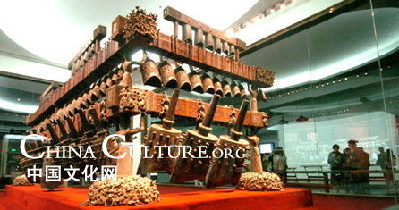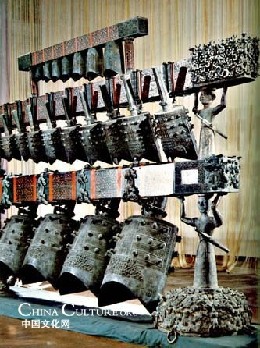|
In 1978, 15,000 articles were excavated from the Zenghouyi (Marquis Yi of Zeng State) Tomb in Suizhou, Hubei Province, including bronze ritual vessels and weapons, horses and carts, articles made of bamboo, lacquer, gold, jade, bamboo tubes, coffins, and musical instruments, among which the Zenghouyi Chime Bells are the most historically important relics.

It is the largest set of bronze bells excavated in the world comprising 65 bells in various sizes, with each bell producing two different tones when struck, which are hung at three levels and are divided into eight groups. There are 19 bells in three groups at the top level, 33 bells in three groups at the middle level and 12 bells in two groups at the bottom level.
The Zeng Houyi Chime Bells are hung on two sets of wood racks. One rack is 7.48 meters long and 2.65 meters wide. The other rack is 3.35 meters long and 2.73 meters wide. The two racks are perpendicular to each other.

The bells cover roughly 5 octaves and the middle 3 octaves produces 12 semitones each. There is an inscription on each bell that records events, musical theories and the sound the particular bell products. From historical records and other materials, it is concluded that there are probably five performers involved in the playing of the bells, with two standing in front of the set playing the larger bells with long poles and three behind playing the smaller bells with smaller sticks.

The bells bear inscriptions that reveal they were gifts from the king Hui of Chu to Yi, the Marquis of Zeng State. The inscription also states that the bell was cast in the 56th year of the reign of King Hui (433BC), the year of the burial of Marquis Yi. The State of Zeng was a vassal state of Chu and was under the same cultural sphere.
The Zeng Houyi Chime Bells weigh a total of 5 tons. The biggest bell is of 153.4 cm in height and 203.6 kg in weight while the smallest bell is of 20.4cm high and 2.4kg weight.
|